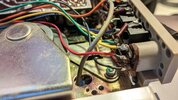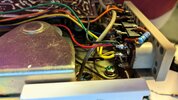I've been trying to fix this old tape recorder in the past couple of days. I have basic knowledge on electronics, still trying to learn. The tape recorder doesn't play any audio, everything else works fine (mechanically speaking). Tested most capacitors and resistors, all of them were fine (except one), no short on the circuit. Speaker is working. No sound on EAR output too.
I narrowed the problem to somewhere around the two 2SB324 transistors (Q4 and Q5), the 2Ω R20 resistor connecting the transistor emitters was visually burnt from overheat, still working, but with higher impedance (13Ω). Replaced the resistor. Reading the voltages on the Q4/Q5 transistors pins I got:
E: slowly increasing from 0.8 volts
C: slowly dropping from 5.4 volts
B: slowly dropping from 5.25 volts
Both transistors are running really hot, to the point of burning the solid/liquid thing around them, inside the heat sink, in less than a minute running (heats faster with a cassette tape on). The resistor I replaced is also burning, probably due to the high current going into it.
Base from transistor Q3 is running at 5 volts instead of 0.8, all components around it are working as intended. Q1 and Q2 are running fine voltage wise. Don't know if it could be the transformers or transistors at fault. I'm stuck here. Don't know where to go from here
I've read this article, he also got a problem at the same kind of resistor, but replacing it didn't work for me.
https://www.electro-tech-online.com...shot-1960s-panasonic-transistor-radio.163778/
The only modification I've made is the resistor swap, all other cables are from factory (presumably)
This manual is the most i could find about this model.
(I don't think the new belt is at the correct position, but that is the only position I could think to make it work correctly)
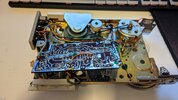
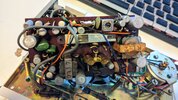
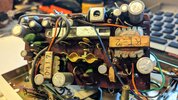
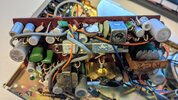
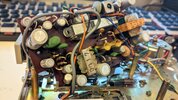
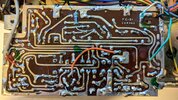
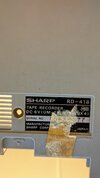
I narrowed the problem to somewhere around the two 2SB324 transistors (Q4 and Q5), the 2Ω R20 resistor connecting the transistor emitters was visually burnt from overheat, still working, but with higher impedance (13Ω). Replaced the resistor. Reading the voltages on the Q4/Q5 transistors pins I got:
E: slowly increasing from 0.8 volts
C: slowly dropping from 5.4 volts
B: slowly dropping from 5.25 volts
Both transistors are running really hot, to the point of burning the solid/liquid thing around them, inside the heat sink, in less than a minute running (heats faster with a cassette tape on). The resistor I replaced is also burning, probably due to the high current going into it.
Base from transistor Q3 is running at 5 volts instead of 0.8, all components around it are working as intended. Q1 and Q2 are running fine voltage wise. Don't know if it could be the transformers or transistors at fault. I'm stuck here. Don't know where to go from here
I've read this article, he also got a problem at the same kind of resistor, but replacing it didn't work for me.
https://www.electro-tech-online.com...shot-1960s-panasonic-transistor-radio.163778/
The only modification I've made is the resistor swap, all other cables are from factory (presumably)
This manual is the most i could find about this model.
(I don't think the new belt is at the correct position, but that is the only position I could think to make it work correctly)







Attachments
Last edited:
